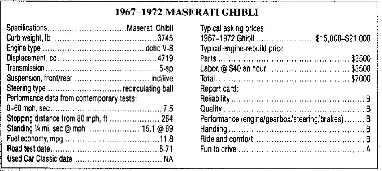 | 330 GT Registry |  |
1967-1972
Maserati
Ghibli
Ferrari and Maserati have always been fierce competitors. Both are located in or around Modena, which is the Detroit of exotic cars. In addition to Ferrari and Maserati, Lamborghini and DeTomaso (as in DeTomaso Pantera) are resident carmakers there. But while Detroit’s automakers cry recession when sales dip to six million cars a year, these tiny Italian companies have altogether averaged over the past 30 years or so less than 2000 sales annually.
Maserati is by far the oldest of the group, preceding Ferrari by some two decades. The company was founded in 1926 when four Maserati brothers decided to build race cars. Over the years the company’s efforts were successful and included a couple of Indianapolis winners. Maserati didn’t actually build road cars until 1946, and even then the 2-seaters did double-duty as road cars and race machines.
However, in 1958, after several costly accidents, Maserati withdrew from factory-sponsored racing and left Ferrari to carry the banner for Italy. From that point on, their rivalry was limited to new-car showrooms. During the Seventies, Ferrari’s prancing horse nearly trampled to death Maserati’s trident in the exotic-car market place; Maserati has now embarked on a different tack by concentrating on building small sports sedans.
Considering Ferrari’s many triumphs in recent years on the sales charts, on race tracks and on television, it’s hard to believe that around 1968 Maserati was selling more GTs than Ferrari. A prime reason was the fabulous Ghibli, named after a hot desert wind. The car blew ‘em away at the 1966 Turin show and Maserati eagerly offered it for sale in 1967. The design was the inspiration of none other than Giorgetto Giugiaro. then a 26-year-old working for the styling house of Ghia.
Ferrari matched Maserati’s move in late 1968 with the Pininfarina-designed Daytona. Despite the many similarities between the two cars, there are several important differences. For one, the Daytona has an independent rear suspension while the Ghibli makes do with a very mundane live-axle, leaf-spring arrangement. On smooth surfaces, the Ghibli rides well enough. But hit some bumps or travel at high speed over undulating high ways, and the car has an unforgiving, stiff ride. “Most uncivilized and unnecessary in a high-budget car,” we said in a 1971 road test. Nevertheless, the Ghibli more than matches the Daytona when it comes to cornering power. In tests during the early Seventies, we obtained a lateral acceleration figure of 0.823g for the Ghibli, compared to 0.817g for the Daytona.
Then there’s the engine. The Daytona has the incomparable Ferrari V-12, of course, but the Maserati’s V-8 isn’t exactly pedestrian. After all, twincam, dry sump, all-aluminum (the block, too) engines with four Weber carburetors are pretty special. The V-8 idles menacingly with lots of burbling from the two big tailpipes.
But like the Ferrari, once the revs start to climb everything seems to smooth out and you get the characteristic sounds and feel of an engine with a racing heritage. (The Ghibli’s V-8 is a variation of the engine from the 450S, one of Maserati’s last race cars.) We found the Ferrari quicker from 0-to-60 mph, and though we never ran a Ghibli flat out, you can be certain it wouldn’t match the Daytona’s 173-mph top speed. But then, isn’t our estimated top speed for the Ghibli of 154 mph adequate for you? I should mention that our Ghibli test car had a 4.7-liter engine. For 1971, Maserati stroked the engine to 5.0.
If you should buy a Ghibli, you’ll get a full complement of luxury-car features, from air conditioning to electric window
lifts. As the late Pete Coltrin, the first journalist to ride in the Ghibli, wrote in R&T, “It differs from many cars of the same performance in that it is as equally suited to going to the opera as blasting down to Palermo on the autostrada.”
Though the Ghibli, and the Daytona for that matter, were essentially hand made, neither automobile’s workmanship matched that of an Aston Martin’s. Ghiblis are also rusters, so search carefully all the usual places for that malady. Other wise, the cars present no particular maintenance problems. The big V-8s aren’t fussy to keep running, and many of the car’s parts are available at auto-parts stores because they’re common to other marques. Most of the major engine components are available from any Maserati dealer because the Ghibli engine is basically the same one that is being used in the current Quattroporte.

ROAD & TRACK October 1985
Copyright 1985, CBS, Inc.
